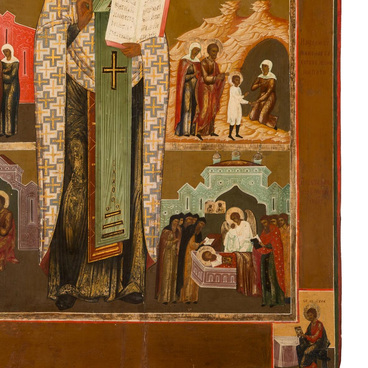The iconographic tradition of the image “Resurrection of Christ with Feasts” became known in Russia no later than the 17th century, in any case, icons dated to that period are present in Russian collections.
For a long time, hagiographic icons were painted according to this type, in which a large full-length image of the saint was in the center, and small-sized hagiographic scenes were depicted around it. Over time, icon painters arranged depictions of main Christian feasts in a similar way.
Pre-revolutionary icon painting centers of Russia, especially Palekh, created a large number of such icons, so these images are often found in icon collections and exhibitions. Due to the complexity and lavish décor of a large number of plots, these artifacts (as a rule, household icons) have medium or large sizes. It would be impossible to place a large number of figures and plots on a small-sized icon board.
The displayed exhibit is an example of the naïve style of icon painting, namely the so-called “krasnushka” or “red” icon. Krasnushka is a simple image: the backgrounds and vestments of the depicted are made with reddish-brown paint, while the images are outlined in black.
The presented image is dominated by red color. Some small areas feature white, black, blue colors and shades of ocher. The naïve manner is evident in the simplified arrangement of figures and gestures, the wrong body proportions, and the naïvely, “childishly” painted faces.
Christ leads the first man Adam by hand, rescuing him from the jaws of Hell; to the right, Eve stands kneeling before the Lord. Christ is surrounded by radiant rays. The icon created by a folk master with such a naïve depiction of the events of the Gospel does not detract from them at all, but, on the contrary, captivates the viewer with its emotional sincerity, childishly touching simplicity, expressiveness, and openness to the Gospel truth.
Depictions of feasts from top to bottom, left to
right:


